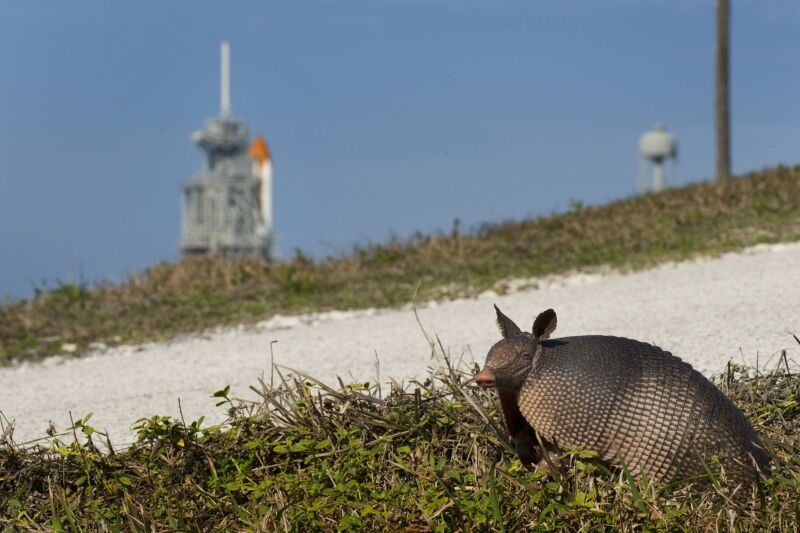Florida man gets unexplained leprosy case; doctors suspect local soil
Enlarge / An armadillo prepares to cross a gravel road as the space shuttle Endeavour rests on the launch pad at Kennedy Space Center before the scheduled launch of STS-130 in Cape Canaveral, Florida, February 4, 2010.
A Florida man’s unexplained case of leprosy last year adds to mounting evidence that the rare and often misunderstood bacterial infection has become endemic to the central part of the Sunshine State—and that it may, in fact, lurk in the environment there, possibly in the soil.
In a research letter appearing in the August issue of Emerging Infectious Diseases, three dermatologists detailed the man’s case and their concerns for local transmission. They note that the 54-year-old man, like several others in the state who contracted the disease, reported no established risk factors that might explain their infection. He hadn’t traveled abroad, where he could have picked up the infection, or had any exposure to armadillos, which live in Florida and naturally carry the bacteria that cause leprosy. He also didn’t have any prolonged contact with people from leprosy-endemic countries or connections to anyone known to have leprosy.
But he did spend a lot of time outdoors; he worked as a landscaper. In fact, many of the recent Florida cases lacked traditional risk factors but reported spending a lot of time outdoors. The similarity “supports the investigation into environmental reservoirs as a potential source of transmission,” the doctors wrote.
In an interview with the Sun Sentinel, the authors speculated further that the man could have picked up the infection through contact with contaminated soil. The infectious earth could have been seeded with leprosy-causing bacteria from armadillos that commonly live in the area. Soil samples from India, where leprosy is endemic, have previously been found harboring leprosy bacteria, they noted.
“Could it be in the soil in Central Florida? We don’t know,” Charles Dunn, a dermatologist and co-author of the study, told the Sentinel. “It is one of the interesting factors to consider in the thought process. We are hoping the scientific community leans into our report.”
Advertisement
In the meantime, Dunn and his co-authors advise dermatologists to be aware of the possibility. “Travel to this area, even in the absence of other risk factors, should prompt consideration of leprosy in the appropriate clinical context,” they wrote in the research letter.
No travel advisory
The suggestion has apparently raised undue concerns that the Centers for Disease Control and Prevention is now working to assuage. The CDC recently added an advisory on its webpage about leprosy—aka Hansen’s disease—noting that the agency “has not issued a travel advisory for Florida, or any other state, due to Hansen’s disease (leprosy).”
The agency also highlighted a series of potentially comforting facts about the disease, which is caused by the slow-growing bacterium Mycobacterium leprae. First, leprosy is rare in the US, even in Florida. There are fewer than 200 cases nationwide most years. Although Florida accounts for a disproportionate number of those cases, with most concentrated in the central part of the state, the case counts are small. So far in 2023, there have been 16 leprosy cases reported in Florida, nine of which were locally acquired cases.
Leprosy is also not very contagious, despite what the severe stigma and ostracism of the past may have led you to believe. It takes prolonged contact with someone infected—often over months—to contract the bacterial infection, the CDC says. Additionally, researchers have estimated that more than 95 percent of people exposed to the bacterium will be resistant to infection via innate, cell-mediated immune responses.
If an infection establishes, it develops slowly, often with an incubation period of three to five years, though it can be as long as two decades. For some, the infection can spontaneously heal after that point. For others, though, it can progress to damage the skin and nerves, causing numbness and hallmark growths, nodules, lesions, discoloration, and ulcers. If left untreated, it can lead to facial disfigurement, chronic ulcers, blindness, paralysis, and loss of function in hands and feet. The slow progression, rarity, and nondescript early skin symptoms mean that some with the disease are misdiagnosed—sometimes for many years.
Once the infection is correctly identified, it can be effectively treated with antibiotics and completely cured. The treatment usually involves two or three antibiotics taken between one and two years, though.
No Byline Policy
Editorial Guidelines
Corrections Policy
Source
